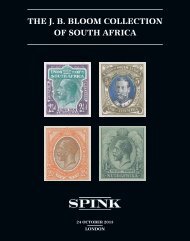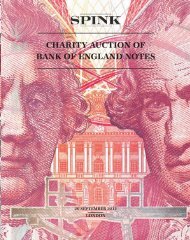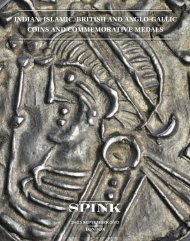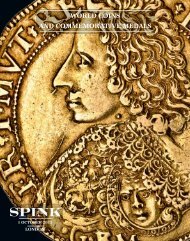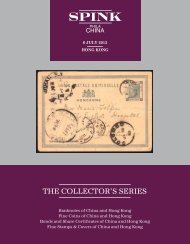orders, decorations, campaign medals and militaria - Spink
orders, decorations, campaign medals and militaria - Spink
orders, decorations, campaign medals and militaria - Spink
You also want an ePaper? Increase the reach of your titles
YUMPU automatically turns print PDFs into web optimized ePapers that Google loves.
November 22, 2012 - LoNdoN<br />
Lieutenant H.A.A. Brosse Flight Lieutenant D.P. Capper<br />
474<br />
Pair: Lieutenant H.A.A. Brosse, Royal Naval Air<br />
Service <strong>and</strong> Royal Air Force<br />
British War <strong>and</strong> Victory Medals (Lieut. H.A.A. Brosse.<br />
R.A.F.), good very fine (2)<br />
£100-140<br />
Lieutenant Hugh Alfred Arvid Brosse, born 1894, a native<br />
of Muswell Hill, London; prior to the war was employed as<br />
an Airship Designer by John Wulffing, 1913-1914; served ‘in<br />
German E. Africa 13 months’ (service papers refer), prior to<br />
joining the Royal Naval Air Service, 7.10.1917; gained<br />
R.A.C. Aviators’ Certificate in a B.E. 2c Biplane at R.N.A.S.<br />
Cranwell, 15.3.1918; posted as a Pilot to 273 Squadron<br />
(D.H. 9’s), R.N.A.S. Yarmouth, August 1918; the squadron<br />
was tasked with coastal reconnaissance <strong>and</strong> on 16.9.1918,<br />
when flying with Second Lieutenant Fenn as his Observer,<br />
‘While on the Yellow Patrol with 2 Yarmouth Boats <strong>and</strong> 1<br />
Yarmouth B.H.P. D.H.9 at approximately 11.45. I sighted 5<br />
Hostile Seaplanes in formation at about 500 feet flying<br />
towards the Coast about 2-3 miles north of Shipwash Light<br />
Vessel; another Hostile Seaplane was afterwards sighted<br />
flying behind the others. I was flying at 4,000 feet. I waited<br />
some minutes for the other D.H. 9 to dive with me<br />
meanwhile I endeavoured to get my gun in action but found<br />
that owing to an oil leak in the C.C. Gear it was only possible<br />
to fire one round for every stroke of the h<strong>and</strong> pump. As the<br />
other D.H. 9 did not show any signs of coming down but<br />
remained with the boats I went down to 1,000 feet alone<br />
meanwhile manoeuvring for position behind the Hostile<br />
Aircraft <strong>and</strong> withholding our fire until within effective range.<br />
As I was descending the Hostile Aircraft altered their course<br />
to due south right into the sun slowly drew away from me out<br />
of sight despite my speed being 90 miles per hour... After<br />
l<strong>and</strong>ing at the Base we found 5 bullet holes in our fuselage’;<br />
after the war he was employed as Director <strong>and</strong> Works<br />
Manager, A Behn (London) Ltd. Wireless Manufacturers <strong>and</strong><br />
served in the Reserve of Air Force Officers until 12.8.1932.<br />
245<br />
475<br />
Pair: Flight Lieutenant D.P. Capper, Royal Naval<br />
Air Service & Royal Air Force<br />
British War <strong>and</strong> Victory Medals (Lieut. D.P. Capper.<br />
R.A.F.), very fine, with a related prize medal, silver<br />
(Hallmarks for Birmingham 1915), the reverse<br />
engraved ‘H.M.S. Indus B.A.A.S. 2nd Tug of War<br />
1916’ (2)<br />
£100-140<br />
Flight Lieutenant Douglas Parode Capper, born Sydney,<br />
Australia, 1898; son of Lieutenant-Comm<strong>and</strong>er Capper,<br />
R.N.; initially enlisted in the Royal Navy as Boy Artificer,<br />
1914; served at H.M.S. Indus (Training Establishment,<br />
Devonport); transferred as Probationary Flight Sub<br />
Lieutenant, Royal Naval Air Service, 25.7.1916; gained RAC<br />
Aviators’ Certificate (no. 4129), flying a Maurice Farman<br />
Biplane, R.N.A.S. Cranwell, 23.12.1916; after training at<br />
RNAS Eastchurch, he was posted as an Observer to 202<br />
Squadron (D.H. 4’s), Bergues, Dunkirk, June 1918; the<br />
squadron was tasked with bombing <strong>and</strong> reconnaissance<br />
missions over Belgium; <strong>and</strong> on 27.6.1918, when flying an<br />
escort operation with Lieutenant Moffett, ‘Encountered 5<br />
Phaltz machines over Ostend. Fired several bursts at two<br />
machines which separated from formation <strong>and</strong> attempted to<br />
cut our machine off’ (Squadron Record Book, refers); on<br />
21.8.1919, when flying an escort operation with Lieutenant<br />
Ringrose, ‘Observed 4 E.A. N. of Zeebrugge. Enemy<br />
Monoplane dived on machine when 8 miles N. of Zeebrugge,<br />
<strong>and</strong> closed to within 70 yards of tail, during which time<br />
Observer fired 50 rounds. E.A. then turned away <strong>and</strong> dived<br />
towards l<strong>and</strong>. E.A. Monoplane dived very fast <strong>and</strong> appeared<br />
to have more speed than D.H. 4 on the level’; two days later<br />
whilst flying with Moffett, ‘On return journey when off<br />
Zeebrugge, observed 2 E.A. Monoplanes about 1,500 feet<br />
below <strong>and</strong> a long way astern of machine. E.A. gave chase, one<br />
shortly giving up, the second catching up with machine,<br />
being on same level <strong>and</strong> 150 yards astern, when Observer<br />
opened fire. At 80 yards tracers appeared to enter his fuselage<br />
<strong>and</strong> he turned sharply <strong>and</strong> dived away. E.A.’s shooting was<br />
erratic. The fuselage of the machine was of dull brown<br />
colour, tail painted white with plain black cross on rudder’;<br />
continued to serve with the squadron until March 1919;<br />
briefly posted to 110 Squadron before being discharged,<br />
October 1919.



